Dealing with unwanted insects is a problem that can be expensive to solve if one was to go the traditional route of hiring a pest control company.
However, multiple cheap and effective DIY insect traps can often be built from materials that inhabit our junk drawers and garages.
This article will cover creating an effective and simple DIY light trap to capture and kill those pesky backyard insects.
Which Insects Can You Trap With a Light Trap
Light traps are effective for flies, moths, beetles, and stink bugs to name a few. Any insect that is attracted to light can find itself caught in the trap.
This style of trap works because the insect flies towards the light and follows it into the trap below, where it becomes trapped and eventually drowns in the soapy water.
What Type of Light to Use?
Traditionally incandescent bulbs were used for these traps, mainly because they were the only option available. However, today we have a much wider variety of lighting styles and types to choose from.
A downside to incandescent bulbs is that they will generally require a socket and power source, limiting your ability to deploy the trap away from electrical outlets.
For this build, we will use an inexpensive UV LED flashlight available on Amazon for between $10 and $20USD.
Ultraviolet light is often better for a trap like this because normal light bulbs give off too much of their light energy in the form of infrared, which insects can not see. In some cases, a normal LED light would attract insects because it warms the air around the trap more than a UV light would.
Since these traps are so inexpensive to build, it would be good to place both a UV and white light LED light trap and see which one works the best.
UV Light Safety
The amount of harmful radiation emitted from a standard UV flashlight is less than what you would experience on a bright summer’s day.
That being said, you should not expose yourself unnecessarily to UV light, and you should NEVER look directly into a UV light source.
Building the Trap
I was able to scrounge through all of my junk drawers and in my garage to build both versions of this style of insect trap.
Making both the traps took me less than an hour to complete.
Related: 6 Traps to Place on Your Property Against Looting Rioters
Tools Required
- Sharp knife or scissors
Materials
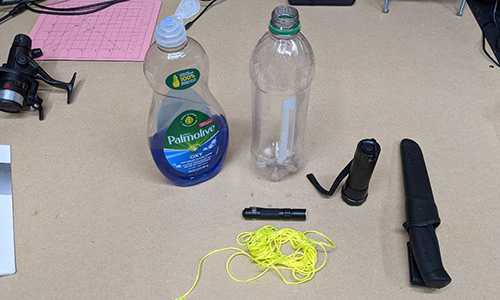 A UV LED flashlight or a white light LED flashlight
A UV LED flashlight or a white light LED flashlight- An empty soda bottle
- Dish soap
- Tape
- Cordage
Instructions
1. Firstly, cut the top from the bottle around where the bottle tapers to the opening.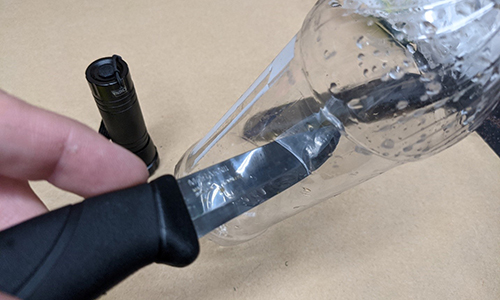 2. Invert the piece that you cut and secure it in place with tape.
2. Invert the piece that you cut and secure it in place with tape.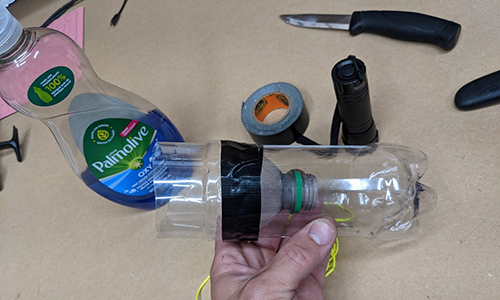
3. Next, poke four holes spaced evenly around the circumference of the bottle at the point where you taped the two pieces of the bottle together.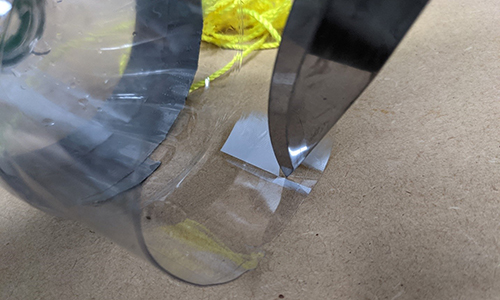
4. Cut four lengths of cordage.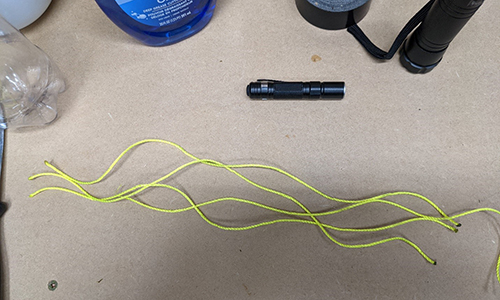
5. Tie one end of each length of cordage to the holes that you’ve cut.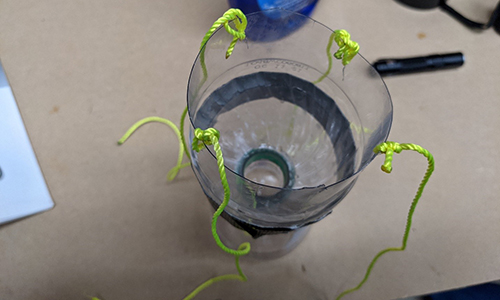
6. Run one of the pieces of cordage through the lanyard hole in the base of the flashlight.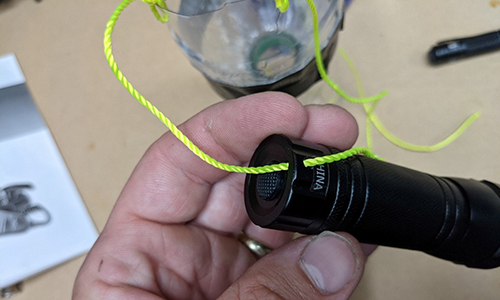 7. Figure out how high you want the light to be and use an overhand knot to secure it onto the cordage.
7. Figure out how high you want the light to be and use an overhand knot to secure it onto the cordage.
8. Tie all four lengths of cordage together so that it can be hung in the air.
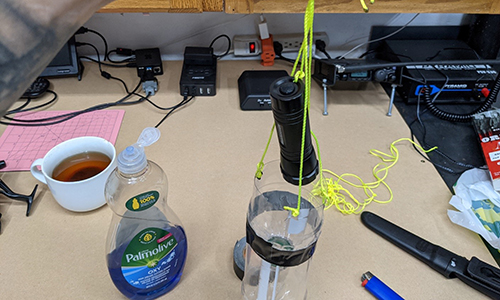
9. Fill the bottle with a little bit of water.
10. Add a couple of drops of dish soap.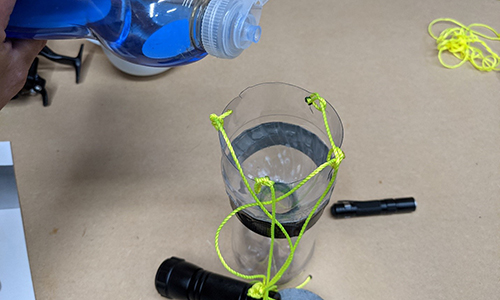
11. Hang the trap where you see insects but away from where you are going about your daily activities like preparing food.
Related: 10 Bugs You Should Never Kill In Your Garden
Variations
There are a few ways to adjust this design to suit your individual needs.
- If you do not want to hang the trap, you can substitute thick wire, such as that found in clothes hangers, for the cordage. Simply bend two lengths of wire into a hoop shape and secure the flashlight where they cross with a zap strap.
- Another option is to make a smaller version of the trap, and instead of using a flashlight, you can use a desk lamp positioned over the top of the trap shining the light down.
- If you want to find out what types of insects in your area are attracted to various light sources, you can also hang a white sheet in your yard and position a flashlight that is either UV or white light to shine down on the sheet. Insects will be attracted to the light, and the white background will help to silhouette them so you can identify the species.
Placement
While it may be tempting to place these traps around areas that these pests are bothering you, such as where you are eating or preparing food, it is better to put them a small distance away to attract the pests away from where you do not want them, and into areas where they can be trapped and killed.
Place the traps adjacent to outdoor living areas and garden areas to keep track of the insects invading your property.
A DIY light trap is a simple method for capturing unwanted insects in your backyard but should not be used as a stand-alone bug trapping method.
Instead, use this method in conjunction with other methods of capturing and killing backyard invaders.
One of the benefits of DIY traps such as the one I’ve detailed here is that they use no toxic substances or poisons and are pet safe.
You may also like:
How to Consume Oak – Nature’s Powerhouse
10 Backyard Projects That Might Get You Arrested (Video)
DIY Condensed Milk Recipe That Can Last More Than 2 Years
5 Maps You Should Have At Home
Going to the Extreme: Euro-Preppers Get Ready for the Worst *Video*

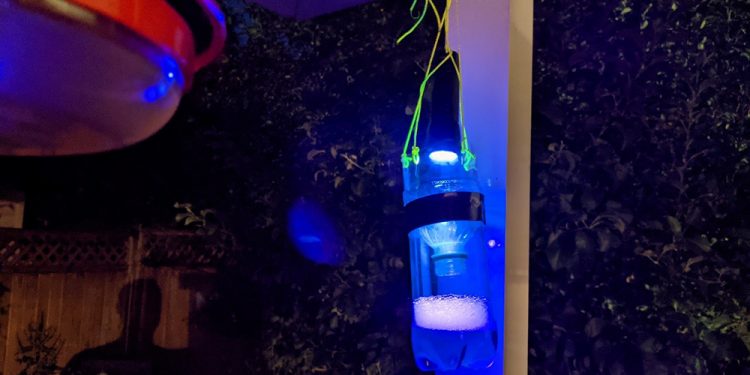














Automatically I have flashbacks of basic training in the army and making sure that the Redlands cap stayed on the whole time because anything else gave up too much light and would give away your position.
That would be my only concern on this in a world turned upside down situation.
But that is the great thing about these articles is the fact that they don’t just apply to a world turned upside down you can adjust as needed even right today 10 years ago whatever.
Red lens, not Redlands. Sorry speach to text + no edit feature.
In Mississippi during the cool months we’re inundated with Asian beetles inside the house. I found that a CFL UV light placed near a sticky board catches huge numbers of bugs. The CFL lamp puts off just a little heat which helps attract the little beasts. No more bugs in my wine glass!
Skunks are a good way to get rid of the beetle grubs, and as I added bonus they can scare away unwanted folks with their scent
Wasps! I need to trap wasps. Is there a light trap that will work on them?
my dad used to make these yellow jacket traps as a kid using meat as bait. For other wasps maybe something sweet as bait. It’s basically a canning jar with a hole in the lid. Then stick an appropriate sized straw or other tubing in the hole and make it flush with lid. The bugs find their way down the straw but are not smart enough to craw back up the straw/tube to get out. A hunk of salmon was his favorite for the yellow jackets. Could maybe make pin holes in the lid to help the scent to get out. Could try Coca-Cola for sweet tooth wasps.
Looks like a good project. With all the rain lately, flies are more than a nuisance. They bite and can cause a lot of diseases. Mosquitoes are booming, too, thanks to several mosquito nurseries in town (AKA lawns). niio
After an end of the world event, with no sanitary services, bugs will once again rule the world. Some traps like the ones described in the article will be worth their weight in the monopoly money we are using today.
The bugs can mess you up. My wife has always been a magnet for biting and stinging critters, we walked through a patch of cane along the Rio Grande years ago and that night she broke out with over 300 chigger bites. We had to break camp and head home, it gave her a fever and knocked her off her feet for several days. A few years later we discovered an absolute devil of an insect in the Ozarks called Oak Mites, they are a chigger type demon that lives in oak trees and launch themselves by the dozens at a passing meal, again in this case, my wife. They raise a burning welt with a head of pus and if you scratch the itch it turns into an open festering wound. stuff like this is very treatable now when we have easy access to antipruritics, antibiotics, and lots and lots of margaritas, but post SHTF all these tiny almost invisible critters can disable and kill you. Then there is the whole problem of tick and mosquito borne diseases like the West Nile Virus that turned my wife into a confused quadriplegic for several months and has left her still too weak to walk. The more I think about it all the less I worry about heavily armed gangsters overrunning my perimeter defenses (imaginary but that happens in all the EMP books) , becoming more concerned with Amoebic Dysentery, Dengue fever, and Chikan-Gunya. Dang, I don’t want the Chikan-Gunya…
Judge Hokden,
So sorry your wife has been so terribly ill.
I also worry about the illnesses caused by mosquitoes and the like.
I have put by mosquito netting for all family members. May sound silly in the PNW, but there is nothing more annoying and possibly deadly than that buzz by your ear as ya lay down to sleep.
Sure hope your wife continues to recover
Peace
MadFab
Thanks for your kindness.
Years ago I did some work for a fabulously wealthy Texan whose estate was on high ground above a creek bottom. He was a bit eccentric, he had a 40′ cantilevered walkway built from his 3rd floor balcony out into the treetops above the creek so he could birdwatch in the mornings. They make systems to fog around your house with pesticide to kill mosquitos and flies, this guy’s idea was to install fog emitters covering his entire home and museum, about an acre of property, and instead of persticide use citronella oil. 5 minutes after it turned on you couldn’t find a mosquito. I’ve looked for a small scale version of it but can’t find one, he must have had somebody engineer it for him. It’s the only thing I’ve ever seen work to truly repel skeeters.
JH: He probably had purchased a smoke generating machine. The company I worked for long, long, ago and far, far away made smoke generators during WWII. After the war they bought all the surplus back. When the Korean War broke out, they sold them to the government again. When the Korean War ended, they bought back the surplus generators. Some of them had not even been shipped but were still mil-wrapped sitting out in the storage yard. I left that company while Eisenhower was still dithering about whether to support de Gaulle in his efforts to retake France’s former colonies in Southeast Asia. I suppose they sold them to the government again when we got involved in Vietnam.
Nothing illegal about what they did. The government decided to declare them surplus property and sell them at 10¢ on the dollar. The company also sold individual smoke generators to various mosquito abatement districts to use to distribute DDT. We used to run through the stuff as the trucks drove around the neighborhoods billowing out clouds of DDT each evening as the mosquitos emerged from their daytime hiding places.
I suppose your employer might have purchased a smoke generator from my former employer to use around his property. I am sure they advertised them to large property owners in the south and to municipal insect abatement districts. Just changing the chemicals changed them from smoke generators to screen military activity to DDT fog generators to kill biting insects. When the DDT settled on grass and plants I suspect it had a deleterious effect on chiggers and ticks as well as mosquitos.
Many insects are attracted to people who have type O blood because it more closely resembles nectar from flowers.
Insects are also attracted to CO2.
According to the University of Maryland Extention Office, light attraction lights like this one create more problems than they solve. Mosquitos, for instance, are not as attracted to these lights as their predators are and therefore, you’re tipping the scales of natural balance against you.
Add a trap with something fermenting in it. Yeast and water with some sugar are good. niio
Well, that was a dead end. I checked the U of M extension website but they will only answer questions for residents of Maryland. The PDRK doesn’t have a similar service. Checking the U of M extension website I didn’t find anything on mosquitos. I checked pests and also insects and pests and found no mention of mosquitos. I wonder if Ms. Brown could post the url for the article she describes in her post so that inquiring minds can read it for themselves.
Well, I couldn’t just leave it at that, so I went on line and just asked generally, “Do bug zappers work?”
There is quite a list of articles about bug zappers. I did find my question repeated followed with “straight vertical line WIRECUTTER. (I can’t find the key for a straight vertical line, so had to spell it out.)
That led me to a lengthy monograph about bug zappers and their efficacy. Let me quote an excerpt from that paper: ““Bug zappers are good for attracting insects that are attracted to bug zappers,” Leslie Vosshall, a neurobiology professor at the Rockefeller University, told us. This often doesn’t include mosquitoes or any other biting insects. A study from the University of Delaware tracked six residential bug zappers over a 10-week period and found that of the 13,789 insects killed, only 31 were biting flies (including mosquitoes). That’s a sad 0.22 percent. Given this, it’s no shock that the authors of the study concluded that bug zappers are “worthless for biting fly reduction.” In a similar vein, the American Mosquito Control Association notes that Notre Dame researchers conducted two studies on bug zappers (neither of which is online) and found that “mosquitoes comprised merely 4.1% and 6.4%, respectively, of the daily catch over an entire season.” As the Colorado State University Extension puts it, “No controlled scientific study has shown that these devices reduce mosquito biting rates outdoors.” (LCC: Which students had to count 13,789 insects of various types?)
If you are interested in a discourse on bug zappers, I highly recommend the article which was originally printed in The New York Times. Not my choice for reliable reporting by any means, but this particular writer seems to have done his homework in researching and reporting on his research.
There is no question in my mind that insects of all sorts will become a serious problem in an end of the world situation. How to deal with them probably would require all of us to become doctoral candidates in entomology. Sorry, right now my dance card is filled up and I just don’t have room for even Bonehead Entomology 101.
It would appear that the methods used in this article would miss the target if one is aiming at mosquitos. It may well be that it does attract certain classes of insects but they may not be the ones we are aiming for.
I think the topic needs more expansion. Perhaps the lady who posted the advisement against using lights to attract mosquitos would be willing to expand on that topic and write an article about mosquito control using something other than a fog generator billowing out DDT vapors.
For the gardeners on the list, are there plants besides citronella which cause mosquitos to leave the area and hunt somewhere else? Are there plants that perhaps even somehow kill mosquitos? I understand bats like to snack on mosquitos but I don’t know if bats can hold down a mosquito population.
As an anecdote about mosquitos. I was stationed with a Marine who hailed from Klamath Falls, OR.
He must have been prepping for a job with the Klamath Falls chamber of commerce because he did nothing but rave about how wonderful Klamath Falls was. When I was contemplating retiring, there were several locales that I wanted to investigate because SoCal was already turning radically left and I have always said I was so conservative I made Genghis Khan look like a Hubert Humphrey liberal. K.F. was on my list. We arrived in K.F. in late afternoon and after checking into our motel, decided to take a walk and view the falls. As we were walking down the trail to the falls, I noticed a large, dark cloud of insects hovering over the trail. From our distance from the cloud I couldn’t tell what they were, but it looked ominous and I felt that closer inspection was uncalled for. We retreated back to our motel. A few hours later, in early evening but after dark we decided to walk over to a restaurant that was adjacent to the motel. Around each light in the parking lot there was a cloud of swirling insects. Hmm. Wonder what they are? Seated in the restaurant, each booth had a large glass window. The booth in front of us and the booth behind us were both empty. The glass adjacent to our booth was covered with mosquitos eyeballing us. The glass adjacent to the two other booths that I could see had no mosquitos. The nasty bugs eyeballed us all through dinner. I don’t know how many thousands watched us eat.
After dinner as we hurriedly scurried to our motel, the clouds around the lights had grown significantly in size. Okay! Scratch Klamath Falls as one of the garden spots of the country for retirement purposes. It occurred to me that the fellow Marine probably had not traveled much in his lifetime to be so enamored of Klamath Falls.
There’s this myth that LEDs emit heat, and that is false. I actually tested this before writing. I turned an LED lamp with 21LEDs to the wall at 3 inches away and left it on 15 hours, then touched the wall: it was cold! There is no heat bi-product to LED light! I do not know if the color of the LED light changes power consumption. I’d get either UV or cool white LEDs. If you’re a beekeeper be aware that bees are attracted to UV light. I use an insect zapper to mitigate the white moth problem, they lay their eggs inside the hive then the juvie moths make a meal of bee larvae. Bees are not nocturnal so the loss of bees to the zapper is rather modest, 25-30 bees in the past 10 days, out of 4 hives with maybe 100,000 bees or more in residence. Moths are nocturnal and they are attracted to light, so I set my timer to turn the light on when the sky has gotten dark gray and no bees are out.
LED are used in greenhouses and grow tunnels in houses. they do not produce a lot of heat, but enough they need to be vented. But, mostly you’re right. niio
Ron: Thanks for a user report from someone who is an actual hands-on user of bug zappers. At least we know that while UV zappers may not attract all that many mosquitos, if one is raising bees in an EOTW situation and one has a solar charged battery bank to run the bug zappers, that is one way to hold down invasive white moths. Another tidbit to add to our overall prepper encyclopedia.
I also appreciate the first hand reporting of an actual test of LEDs. I understood that one of the reasons for their long life was the fact that they emitted much less heat than normal incandescent lights. They do emit heat, however, as the newer 1000 and up lumen lights get too hot to touch the glass which is a special glass that won’t fracture or melt when confronted with searing heat. I kinda think that my freebie Harbor Freight 9-LED, 3-AAA battery flashlight lenses are just clear plastic.
It’s amazing to an old fart who used to read books under the blankets with the aid of a flashlight that usually went dead before I could finish the book the way flashlights have developed in just a few short years. According to what I have read, the reason they are called flashlights is because when they were first introduced the components were so weak that the only way they could be used was to flash them on and off, hence “flashlight”. Don’t know if that is true or not. I only look old enough to have been around at the introduction of flashlights.
It just amazes me that a hand-held light will throw a beam almost as bright as the old arc lights they used to use to advertise store openings or the first few days of a new movie in front of the movie theaters. Anyone remember those days? That also harkens back to the days of skywriters. I suspect there are only a few who remember the days of skywriters. We still have a banner tower, a bi-plane that will tow a banner behind it. He or she is another of a dying breed. Used to see banners being towed along the beach every weekend when we first moved to this town. Now I only see that sole surviving banner tower a couple times a year.
Ha, Klamath Falls Chuck, that’s a good story. I think you’re on the right track with the smoke generator, seems like you’d have to have high heat to vaporize the citronella oil and mix it with water to make a fog?
A fact based on my experience, the citronella plant they sell in stores does not repel mosquitoes. Mosquitoes are a life form superior to us. America had a bad malaria problem all along the East Coast and through the Gulf States that apparently began with the introduction of slaves from the Caribbean. I have read that in the 1st hundred years of the Virginia Colony the average survival expectancy of a European immigrant was 5 years, A slave 2 years. Malaria persisted in the South until the 1960’s when wetland drainage, the end of share cropping with a huge population drop in the rurbitesuth, and the introduction of air conditioning brought malaria to an end.
We have a skeeter here called a ‘no see ’em’ ( we have a gnat here called a Bull Gnat, but that is another story), they can squeeze through the mesh of a window screen so you can’t leave a window open, you don’t see them or feel them when they bite but suddenly your arm is on fire with 10 or a dozen bites. Why are there mosquitoes?
According to the novel, Mrs. Mike, in Alaska when the bigger blood suckersd can’t get in to torture you, they’ll shove the small one thru the screen 🙂 niio
Judge: According to a book I read about the malaria epidemics that used to plague the eastern seaboard and the Caribbean islands, malaria almost cost us our first government. The government at that time was headquartered in Philadelphia which in the early years of our government suffered from malaria outbreaks every time a ship from the Caribbean arrived in port in the warm months. There was heavy traffic between the original 13 and the Caribbean Islands because they raised sugar in the CIs and the original 13 used sugar which they couldn’t grow because it was too cold to make rum and assorted other alcoholic drinks, but particularly rum and so it was a round trip affair. The ships arrived with sugar cane and went back with rum. All the while, the ships were bringing malaria to the original 13.
The book was specifically about malaria which was originally thought to be caused by bad air around the pools of water (mal aria) that was thrown out of various businesses and households into the gutters in the streets which were open to the air. One of the early efforts at reducing malaria was to drain and otherwise clean up the standing pools of water. Of course that made the air smell better but the real cause for joy was it reduced the mosquito population dramatically. If I can find it on my Kindle list, I will post the title. It was a fascinating read and in the back of my mind as I was reading it, I was wondering how long it would take for malaria to once again become the scourge that it was in the 18th century after an EOTW event. Even today, with the growing insect resistance to DDT and the legislated demise of that mosquito killer, malaria has reared its ugly head and accounts for deaths in the hundreds of thousands if not millions each year. It truly is the scourge of mankind in the tropics and will become more so for folks living in the malaria belt in the event of the collapse of civilization as we know it.
Hence my question about plants and available chemicals to ward off mosquitos. Although where I live in SoCal, standing ponds of water are as scarce as an honest PDRK politician. We had a rain storm this past week only everything is so dry the rain evaporated before it reach the ground. The only indication that it was raining was the smell of the rain in the air accompanying the dark clouds. Even the car in the driveway which usually is the first indication of rain was dry as a skull in Death Valley.
LCC: Citronella plant, peppermint, I think geraniums, lemongrass. The best skeeter beaters are still swallows and bats. The drought drove off the bats, and the swallows here all hang out over by the open air stables across town. Another thing that’s good to beat mosquitoes is Roundup on every lawn. A number of mosquitoes will lay eggs in a wet lawn. If the eggs or larva dry out, they come back the next time the lawn is soaked and grow. A cousin has a small fish pond in her backyard that she claims keeps the population of most biters down. niio
A properly constructed batbox positioned in an appropriate place and height will do wonders for getting rid if mosquitoes and other unwanted pests in a garden. Although it may take 2 or 3 years for the bats to discover the box, once they take up residence in the box it’s real entertainment at dusk when hundreds of bats emerge.
That’s a wise idea. niio
Artimesia is what I would grow for anti-malaria. I spent 3 years in Southern Africa and malaria is a SCOURGE. 15 yrs ago some of my doctor friends there were looking at Artimesia and trying to get some on hand to experiment with.
https://medium.com/@nefsciart/fighting-malaria-in-africa-researchers-turn-to-banned-artemisia-to-save-500-000-dying-yearly-8830e46a72dd